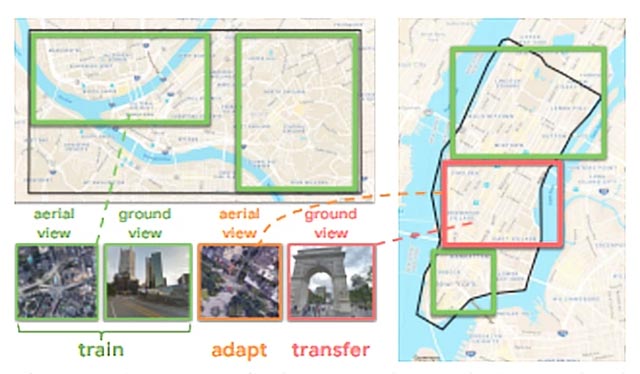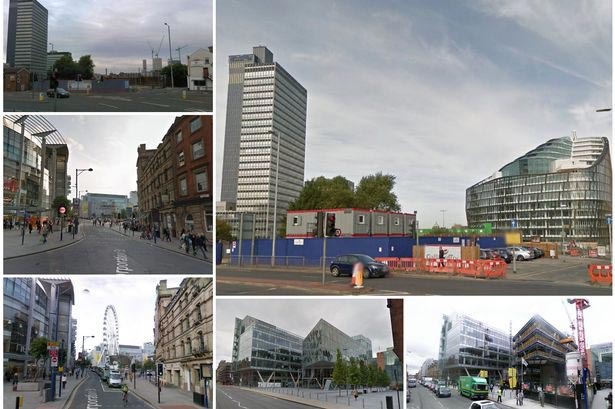AI models use aerial and ground data to navigate areas that are difficult to observe
Can artificial intelligence models help navigate through areas (streets) that they have not previously trained, or have not been provided with enough training data? That is what scientists at the development team of DeepMind artificial intelligence concern. And after years of incubation, scientists have finally achieved success in a study called 'Cross-View Policy Learning for Street Navigation', recently revealed in an article. published on Arxiv.org.
In this study, DeepMind scientists have described the development of an AI-trained policy from a wide range of data warehouses (mostly images taken from top to bottom), targeting different areas of the city, for more effective observation. Researchers believe that such an approach will result in better generalization.

- The difference between AI (Artificial Intelligence) and Cognitive Computing (Cognitive Computing)
In essence, this study is inspired by how quickly people can adapt to the layout and basic structure of a new city by scrutinizing the city's map very much. times.
'The ability to navigate from visual observations in unfamiliar environments is a core component in studying the ability to learn the navigation of AI models. The ability to navigate the streets in the absence of training data of AI models is still relatively limited, and relying on simulation models is not a possible solution for long-term long. Our core idea is to pair the ground observation mode with the aerial observation mode and learn the general policies that can allow switching between views', representative of the research team. said.
- Google released a huge AI training data warehouse with over 5 million photos of 200,000 locations worldwide
More specifically, the first step that researchers will have to do is to collect aerial maps of the area they plan to navigate (in combination with street-based observations based on geographic coordinates). correspondence). Next, they embarked on a three-part shift mission, starting with data training and adjusting the source area using aerial observation data, and ending with moving to the targeted area by observing data from the ground.
The team's machine learning system contains three separate modules, including:
- Convolutional module, responsible for visual perception.
- Long-term memory modules (LSTM) are responsible for obtaining specific characteristics by location.
- The policy recurrent neural module helps create division through actions.
This machine learning model has been deployed in StreetAir - a view of many outdoor street environments - built on the StreetLearn basis. (StreetLearn is the first interactive panoramic photo gallery extracted from Google Street View and Google Maps).

- AI uses tweets to help researchers analyze the flood situation
In StreetAir and StreetLearn, the images above do not contain the whole of New York City (including Downtown NYC and Midtown NYC) and Pittsburgh (campuses of Allegheny University and Carnegie Mellon) are arranged so that each latitude coordinates degree and longitude, the environment returns an aerial image at 84 x 84 in size, the same size as the image from the ground.
The AI system, after going through the training process, will be tasked with learning how to localize and navigate a panoramic image chart of Street View with the latitude and longitude coordinates of the destination.
Panoramic images covering areas from 2 to 5 km apart, about 10m apart, and vehicles (AI control) will be allowed to perform 1 in 5 actions each turn: move forward , turn left or right 22.5 degrees or turn left or right 67.5 degrees.
When approaching the target location within 100-200 meters, these vehicles will receive 'rewards' to encourage the identification and passing of intersections quickly and precisely. body.

- MIT AI model can capture the relationship between objects with the minimum amount of training data
In the experiments, the means to exploit aerial imagery to adapt to the new environment achieved a reward figure of 190 at 100 million steps and 280 at 200 million steps, both of which were significantly higher. counting compared to vehicles using only ground observation data (50 at 100 million steps and 200 at 200 million steps). According to the researchers, this result has shown that their approach significantly improves the ability of vehicles to acquire knowledge about multiple areas of the target city more efficiently.
You should read it
- The difference between AI, machine learning and deep learning
- 6 steps to start learning artificial intelligence programming (AI)
- Artificial intelligence learns to create another artificial intelligence, replacing people in the future
- [Infographic] Benefits and hazards from Artificial Intelligence
- AI can now help write the biographical pages on Wikipedia
- Google: Android users prefer to use 3 traditional navigation keys than 'inspired' gesture navigation from iOS
- Deep Learning - new cybersecurity tool?
- Custom tips for virtual navigation keys on Samsung phones are more convenient
May be interested
- Navigate directly from table to table in Word 2013
 the cursor is not in the table to jump to the next table. place the cursor on any paragraph or table and press f5 (or use ctrl + g) to open the find and replace dialog box. the go to tab of the dialog box is automatically selected. select table in the go to what list> click next.
the cursor is not in the table to jump to the next table. place the cursor on any paragraph or table and press f5 (or use ctrl + g) to open the find and replace dialog box. the go to tab of the dialog box is automatically selected. select table in the go to what list> click next. - Coreldraw - Lesson 9: Road drawing tools (continued)
 the pen tool is used to draw lines, curves and closed areas. with the pen tool, draw the curves faster. the drawing is similar to the bezier tool, but according to the drawing line with the cursor, it is easier to navigate.
the pen tool is used to draw lines, curves and closed areas. with the pen tool, draw the curves faster. the drawing is similar to the bezier tool, but according to the drawing line with the cursor, it is easier to navigate. - How to fix broken data on PS4
 corrupted data error (corrupted data) on the ps4 sounds like a serious problem. the reason is largely because the sony console is a closed system, difficult to fix but the internal components often have problems.
corrupted data error (corrupted data) on the ps4 sounds like a serious problem. the reason is largely because the sony console is a closed system, difficult to fix but the internal components often have problems. - Choose what age to land at the beginning of the year when Dinh Dau gave the family lots of luck
 on the first day of the new year, vietnamese families often choose good people, homeowners to storm the land (home) with the wish that everything will be smooth, smooth and peaceful ... so in the new year of rooster dinh, age which would be suitable to land?
on the first day of the new year, vietnamese families often choose good people, homeowners to storm the land (home) with the wish that everything will be smooth, smooth and peaceful ... so in the new year of rooster dinh, age which would be suitable to land? - Photoshop CS: Creativity with New Year's greeting card (Part III)
 have you practiced good ground and ball design for this tet card? do you encounter any difficulties? don't be discouraged when you encounter any difficult steps. the result of labor when you create a postcard yourself is the greatest joy
have you practiced good ground and ball design for this tet card? do you encounter any difficulties? don't be discouraged when you encounter any difficult steps. the result of labor when you create a postcard yourself is the greatest joy - Older women often have this habit.
 some women don't suddenly become difficult with age. these subtle habits build up over time and signal that they're going to become more difficult.
some women don't suddenly become difficult with age. these subtle habits build up over time and signal that they're going to become more difficult. - How to Celebrate Easter During Coronavirus
 celebrating a holiday like easter is often a special time for families. even though the coronavirus outbreak may make it difficult to celebrate the way you normally would, you can still observe easter in your own way at home. with a little...
celebrating a holiday like easter is often a special time for families. even though the coronavirus outbreak may make it difficult to celebrate the way you normally would, you can still observe easter in your own way at home. with a little... - 10 dreadful situations that are difficult to understand everyone have experienced
 sometimes life is so busy that we don't even notice what happens around us. if you try once to observe people closely, you will see how different we are, but sometimes we encounter similar situations.
sometimes life is so busy that we don't even notice what happens around us. if you try once to observe people closely, you will see how different we are, but sometimes we encounter similar situations. - How to remove periods in numbers in Excel
 how to remove periods in numbers in excel when typing a string of numbers, data entry people have a habit of inserting dots in the middle to easily observe the data and reduce errors when entering data. however, in some cases, the dot will make the calculation impossible.
how to remove periods in numbers in excel when typing a string of numbers, data entry people have a habit of inserting dots in the middle to easily observe the data and reduce errors when entering data. however, in some cases, the dot will make the calculation impossible. - Protect data on CD with Secure CD
 copying data on cd is quite easy, so it is very difficult to protect your important data on cd. great-wall software's secure cd is a program that helps you in securing data on cd.
copying data on cd is quite easy, so it is very difficult to protect your important data on cd. great-wall software's secure cd is a program that helps you in securing data on cd.










 5 genius minds in the AI field join hands to create awesome robots
5 genius minds in the AI field join hands to create awesome robots AI classifies objects on the road only by radar measurements
AI classifies objects on the road only by radar measurements The future of AI and people is cooperation
The future of AI and people is cooperation MIT strives to develop an AI model that can drive almost like a human
MIT strives to develop an AI model that can drive almost like a human Microsoft AI creates a real voice with only 200 training samples
Microsoft AI creates a real voice with only 200 training samples EU: AI systems should be developed and implemented in a transparent and responsible manner
EU: AI systems should be developed and implemented in a transparent and responsible manner